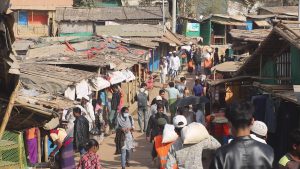More deaths at sea, another capsized boat and more tragedy. This time it is Rohingya fleeing either persecution in Myanmar or unlivable conditions in makeshift camps outside the country. Seventy deaths and counting from the latest incident alone.
The trendline for Rohingya escaping on boats to head for places like Indonesia or Australia is showing a marked increase in numbers. From 2021 to 2023, the United Nations recorded a 441 percent increase in “irregular movements” of Rohingyas seeking to escape places like Kutupalong, the world’s largest refugee camp, in Cox’s Bazar, Bangladesh.
In the last year, according to the UNHCR some 4,500 Rohingya embarked on treacherous sea journeys, seeking asylum in Southeast Asia and Australia.
Of that number in 2023, 569 perished, a death rate of around one in eight. Sixty-six percent of those fatalities were women and children.
No one takes such a risk unless compelled by unendurable stresses. This is an undoubted humanitarian crisis that needs a regional solution.
Not only is a more workable and humane system required for Rohingya asylum seekers, but more needs to be done to get the military junta in Myanmar on board and return the country to the, albeit imperfect, version of democracy that existed before the 2021 coup (noting of course that the Rohingya Muslim minority was heavily persecuted even in pre-coup Myanmar).
The recent ASEAN Summit in Melbourne should have been an opportunity to develop such an approach. It didn’t.
The summit delivered little more than a reiteration of ASEAN’s Five-Point Consensus on Myanmar. The consensus calls for an end to violence, formal dialogue between all parties in the country, open channels for humanitarian assistance from ASEAN, the appointment of a special envoy, and for that envoy to have access to all parties inside Myanmar.
The tameness of this consensus is confirmed by the fact that the current military leader in Myanmar, Min Aung-Hlaing, actually agreed to formally accept its conditions in 2021.
The summit declaration following ASEAN’s Melbourne meeting stressed the importance of ensuring “safety and security for all communities in Rakhine State,” where Rohingya are the majority group, and to “facilitate the voluntary return of displaced persons in a safe, secure, and dignified manner” to Myanmar.
The group made no real mention of the growing regional crisis of asylum seekers fleeing Myanmar.
A regional approach to asylum seekers has to start from an agreement that the region should not further facilitate the military regime’s decades-long campaign of ethnic cleansing in Rakhine state, nor should the region help rid the Myanmar dictatorship of its opposition. Any approach to the Rohingya crisis has to start with a return to democracy in Myanmar, the peaceful repatriation of refugees, and an end to ethnic and political persecution.
That being said, a more coordinated response would open more formal channels for asylum seekers to seek refuge in other countries. Southeast Asian countries might increase their quotas, but they also need to find ways to allow Rohingya and other people from Myanmar to get out and find safety.
A possible entry point for this might be the commitment known as the Responsibility to Protect (R2P). Established at the U.N., via a unanimous vote in the General Assembly in 2005, this instrument remains under-utilized and often misunderstood. R2P obliges national governments to use “appropriate diplomatic, humanitarian and other peaceful means…to help protect populations from genocide, war crimes, ethnic cleansing and crimes against humanity.”
While R2P might present a group solution, someone needs to lead and coordinate such a program.
In Australia, we know that people from Myanmar make good immigrants. Most Australians are also well aware that Australia has been mired in a labor shortage crisis, whereby important sectors such as education, nursing and aged care cannot find enough staff.
Australia, therefore, stands at an important point in regard to asylum seekers and migrants from Myanmar. There is a potential win-win for the nation and for a humanitarian outcome if a mindset shift can be achieved.
But the potential to lead is often at risk.
In Australia, as elsewhere, there has not only been a failure of policy, but one of narrative. Migration, humanitarian and economic, has become subject to an ongoing descent into the depths of fear-mongering and discrimination. Indeed, these narratives have, too often, and for too long, informed policy, despite overwhelming evidence to the contrary.
Last year, the Business Council of Australia released data showing that “for every 1,000 migrants, there is a $124 million economic dividend each year to Australia.” Meanwhile, the Scanlon Institute, a private NGO published research last year in partnership with major universities which found that 86 percent of Australians think immigrants are good for Australia’s economy and that 89 percent agree that multiculturalism is good for the country.
Shifting the narrative to incorporate and promote these viewpoints can impact the entire region. Allowing these attitudes to drive better policy outcomes may well save the lives of future refugees setting out to escape military rule.
Empty policy, supporting marginal perspectives, costs lives. The Rohingya asylum seeker crisis is a human-scale problem that requires a human-scale solution across the region.

































